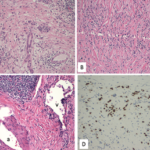Historically, the term lupus has been applied to many different ulcerative diseases. Dr. Kolfenbach explained, “Lupus is Latin for wolf, and one of the proposed origins of the term derives from the red fur distribution over snout and cheeks in the red wolf that resembled the pattern of cutaneous involvement in patients with [lupus pernio],” he said. He emphasized the importance of recognizing that this pattern is seen in sarcoidosis and not in systemic lupus erythematosus.
Clinical pearls can be useful when randomized controlled trial data are not available for a particular question or when the data are available but don’t address a particular patient’s clinical scenario.
All About that CRP
5. Increased levels of C-reactive protein (CRP) are not typical in systemic lupus erythematosus (SLE) flares, Dr. Kolfenbachexplained, perhaps due to downregulation of interferon-α and/or the presence of anti-CRP antibodies.
Thus, it is important to rule out infection in patients with SLE and an elevated CRP. However, elevated CRP can be present during lupus flares accompanied by significant serositis or arthritis, or in patients with a concurrent malignancy.
IgG4-Related Disease & Mimics
6. Dr. Stone dispelled the myth that coronary aneurysms are only seen in one rheumatic condition, Kawasaki disease. He noted IgG4-related disease (IgG4-RD) can cause coronary arteritis and lead to striking coronary aneurysms: Ten patients followed in his IgG4-RD clinic have coronary involvement. This manifestation is most common in male patients with long-standing disease and high serum IgG4 concentrations.
7. Beware of mimics: Dr. Stone explained that not all periaortitis is related to a vasculitis or retroperitoneal fibrosis from IgG4-RD. He discussed a case involving peri-aortic inflammation in which the patient had a thick ring of inflammation around the kidneys, termed hairy kidneys. This finding is not present in IgG4-RD, but is instead a marker of Erdheim-Chester disease, a histiocytic disorder.
Gout Pearls
8. According to Dr. Kolfenbach, retrospective studies have demonstrated most prescriptions for allopurinol in the U.S. are at doses of 300 mg daily or less, but at this prescribed dose, only around 45% of patients achieve the serum uric acid goal of <6 mg/dL recommended by the ACR 2020 gout guideline. Thus, Dr. Kolfenbach emphasized the importance of uptitrating allopurinol, escalating above 300 mg daily if necessary to achieve the patient’s goal serum uric acid level.
9. Dr. Kolfenbach also discussed thinking about the possibility of non-adherence if a patient is failing to respond to allopurinol.Before escalating to such therapies as pegloticase, practitioners should investigate whether lack of clinical response represents a failure of the drug itself or a patient’s failure to take the drug.


